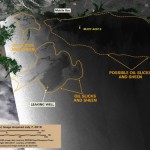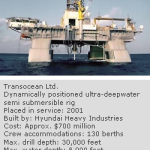A few days Chris Rowan of the fabulous geology blog Highly Allochthonous wrote a good post on the risky business of drilling for oil. In it, he compared the current disaster to the Lusi:
“I have been struck by several parallels between events in the Gulf of Mexico and Lusi , the mud volcano in Indonesia that is widely believed to have been triggered by exploratory drilling. In both cases, drilling was taking place in a difficult drilling environment with low margins of error (in the case of Lusi, the suspect hole was drilled in an area ‘primed’ for mud volcano formation). In both cases, the drilling companies did not follow absolute best practice (in the case of Lusi, they failed to case the well, which would probably have prevented the blow-out). In both cases the environmental and economic consequences for the surrounding area are severe and of long duration.”
You’ll have to go there to get the rest of the story. But I wanted to also highlight an excruciatingly detailed comment from an email of a rig worker who happened to work on Deepwater Horizon, but wasn’t there the day it all fell apart. I’ll only quote a little bit, but it is very enlightening and worth heading over to Highly Allochthonous to read it in its entirety.
“When they did this, they of course took away all the hydrostatic on the well. But this was OK, normal, since the well was plugged both on the inside with the casing and on the outside with the tested packoff. But something turned loose all of a sudden, and the conventional wisdom would be the packoff on the outside of the casing.
Gas and oil rushed up the riser; there was little wind, and a gas cloud got all over the rig. When the main inductions of the engines got a whiff….”
Although it should be noted that Southern Fried Science has its own theory of how this all might have occurred. Perhaps it was a sabotage effort by marine life. Head over there for a must-see video from an oil rig ROV.
To add yet another level of complexity on this issue, the remedy might be just as bad, or worse, for Florida’s coral reefs. Lisa Speer, Director of International Oceans Program at NRDC, wrote on their Switchboard:
“When an oil spill happens, the first thing many people think of are the beaches, wetlands, birds and other life along the shore. And the impacts of oil on that life can be huge and devastating. While dispersing the oil with chemicals may help reduce shoreline impacts, it’s a trade-off that still comes at a great cost.
That’s because dispersants don’t make oil go away – they merely shift the oil and its impacts away from the surface and into the water and the sea floor, where they can cause less visible but equally devastating damage[.]…”
The rest of her article outlines in very good detail what this threat is and worth the full read. It is very disconcerting and makes me really wonder how much damage will be done to the Gulf landscape because our quick-draw, instinctual responses to remove the visible threat of the oil slick. How much regard is going to go into thoughtful planning during this containment and the following recovery period? Citizens, environmental watchdogs and scientists need to be very vigilant in these times!
If you want to track the impact of the oil spill Louisiana Bucket Brigade website has a really good interactive Oil Spill Crisis Map. Additionally Google has an interactive Google Earth map where you can add layers to see how the oil slick has shifted over the last few days and more. The official website for the Deepwater Horizon Response Unified Command has photos of their controlled burns up. As @davemunger joked on Twitter “Wow! At this rate it’ll all be gone in, oh, 50 years or so!”






2 Replies to “Oilmageddon Update May 7”
Comments are closed.